Astros Draft: Looking at the positions of need for early picks

Looking at the Top Astros prospects to see what positions that need to be addressed during the draft.

Here we are, days away from the 2017 MLB Amateur Draft. The Houston Astros will have five of the top 100 picks of the draft. With the picks received by St. Louis Cardinals for Hackgate, the five picks are 15, 53, 56, 75, and 91. The Astros are done with the top five picks stage of the franchise, but they can still get a good player at 15.
Looking at the recent phistory of the 15th pick, the most notable player drafted was 2004 when Stephen Drew was picked. Scott Kazmir was drafted with the 15th pick in 2002 and Chase Utley in 2000. I could keep going, but as you can see, the 15th pick is not guaranteed success. However, Mike Elias and his team have spent months scouting potential targets.
Two years ago they drafted Alex Bregman and Kyle Tucker in the first round. They are showing the talent. Bregman has already reached the bigs, and Tucker could make his debut next year. The Astros front office has already planned out this year’s draft. Let’s take a look and see what positions the Astros need to address the most.
Granted, the Astros will most likely draft the best available players. But let’s find the weakness in our farm system.
Catcher
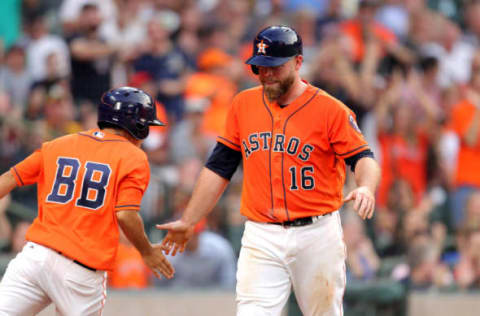
By Eric Huysman
Next: Garrett Stubbs (#11, MLB Pipeline)
Backup: Juan Centeno
Depth: Max Stassi
Future: Jake Rogers (#21, MLB Pipeline)
At one time, this was a weakness in the Houston Astros farm system. They addressed it by drafting Jason Castro and trading for Stassi. While Stassi demonstrated some power in the minors, he was never the same after being hit by a pitch. Stassi has been removed from the 40-man roster and possibly from the plans.
Right now, the Astros are covered with Brian McCann and Evan Gattis through at least 2018. Without much of a need of a catcher in the immediate future, Centeno has already shown he can be a capable MLB backup catcher.
The prospects.
Looking at the actual prospects, Stubbs is the closest to being ready. He has gotten off to a slow start at Double-A, only batting .239 with three homers and 14 RBIs. While he might be undersized as a catcher, but he could be faster than your typical catcher. There is no room at Triple-A at the moment, but he will be moving up at some point.
Rogers was drafted in the third round of the 2016 MLB Draft. While he was drafted more for his defense, he has shown some great offensive numbers this year. He is batting .284 with nine homers and 26 RBIs between Low and High-A ball. The next step for him will be Double-A, which could be later this year.
Need: Not critical, level 5
First Base
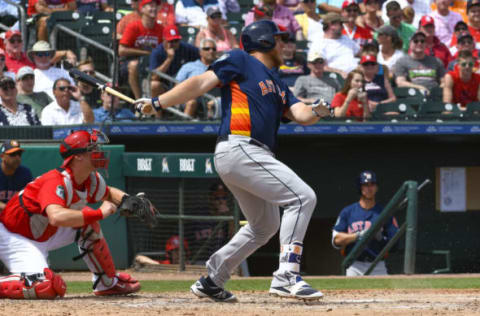
By Collin Gay.
Next: A.J. Reed
Backup: Tyler White
Depth: Colin Moran (#23, MLB Pipeline)
Future: Yordan Alvarez (#14, MLB Pipeline)
At this time last season, the Astros seemed to have a lot of promise at the first base position. On Opening Day of the 2016 season, the Astros had a top prospect in A.J. Reed that seemed to be the future of the first base position. Now, after a disappointing major league stint last season and underwhelming numbers since his demotion back to Triple-A Fresno, the first base question still may have to be on the table.
That is not to say that Reed’s upside has decreased. He still has the opportunity to be a middle-of-the-order hitter for the Astros for years to come. So far this season, he has 23 extra base hits, including eight home runs, and has driven in 33 RBIs. However, after never hitting below .270 before his major league call-up, Reed is only hitting .254 with only a .437 slugging percentage. Part of that has to do with his strikeout numbers, with 70 strikeouts in 213 at-bats.
Despite the extremely high expectation attached to Reed, his success, or lack thereof, does not determine the future success of the position. First of all, Tyler White, another Fresno first baseman with some major league playing time, could provide serviceable playing time until a long-term answer is found. More of a contact-first hitter, White has turned into more of a utility man in his time with the Grizzlies, finding playing time all around the infield.
The prospects
However, if Reed is not the answer, a 19-year-old in Single-A Quad Cities may be it. Acquired in the deal that sent RHP Josh Fields to the Los Angeles Dodgers, Yordan Alvarez has been tearing it up for the River Bandits this season. Named to the Midwest League All-Star team, Alvarez is hitting .413 with five home runs and 20 RBIs with a 1.193 OPS. If Reed is not working out, it would not be surprising to see the young Cuban on the fast track to the majors here soon.
The Astros and the first baseman position is a love/hate relationship. Even with seemingly youthful and exciting talent, there seems to be a lack of production. First base is always a position that the Astros could look for more depth in.
Need: Moderate, level 3
Middle Infielders
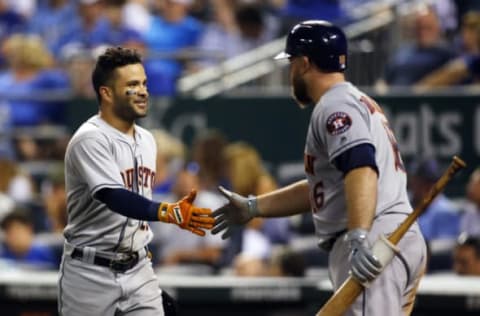
By: Eric Huysman
Next: Tony Kemp
Backup: Nick Tanielu
Backup: Reid Brignac
Depth: Anibal Sierra (MLB Pipeline, 17)
Future: Miguelangel Sierra (MLB Pipeline, 10)
Deep Future: Freudis Nova (MLB Pipeline, 15)
Future: Jonathan Arauz (MLB Pipeline, 18)
I paired the two middle infielders together because there are not too many true second basemen in the system. After all, we have Jose Altuve playing second base. On the other side, the shortstop position has plenty to offer. A shortstop can easily be moved from second to third base because they are typically the most athletic on the team.
As we saw in the 2015 draft, the Astros drafted Alex Bregman and he rose through the system quickly. Arauz was part of the Ken Giles trade as a throw in. Luhnow has done a good identifying young talent in the lower level of other teams. Arauz did come with some baggage this season as he was suspended for 50 games.
The prospects.
Arauz could be the future star here, but Sierra could be the overall better player. There are not too many standouts in this category, so I could see them drafting a middle infielder early in the draft. They have a backup second baseman in Kemp and shortstop in Brignac. There is plenty of depth in the lower levels of the Astros minor leagues in the middle infield.
They could go after a college middle infielder with one of the draft picks, but there is no rush with Correa and Altuve settled in.
Need: High, level 1
Third Base
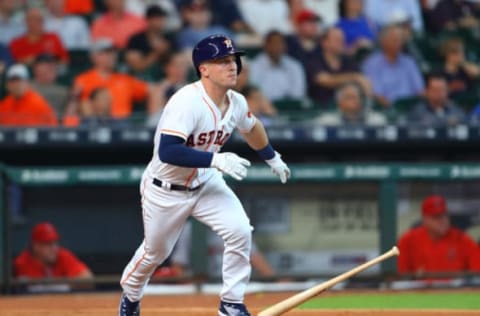
By Colin Gay.
Next: Alex Bregman
Backup: White
Depth: Moran
Future: J.D. Davis (#13, MLB Pipeline)
With former No. 2 overall pick Alex Bregman manning the hot corner at the major league level, the Houston Astros are in no real hurry to develop depth at the third base spot. The Top 30 prospects list shows just that. Colin Moran and J.D. Davis are the only two players on the list that primarily play the third base position. However, both players could not be more different,
Acquired from the Miami Marlins in the Jared Cosart deal, the left-handed hitting Moran is mostly a contact first type of hitter. A career .285 batting average in the minor leagues, Moran only has a .416 slugging percentage. However, this season wit Triple-A Fresno, he has developed a bit more power, hitting 18 extra-base hits, including nine home runs, to go along with his .270 batting average.
In his short stint at the major league level in 2016, the biggest struggle for Moran was his approach at the plate. Coming into his major league debut with a strikeout percentage over 20 percent, Moran struck out eight times in 25 plate appearances. It does seem like that is something he has been working on though. His strikeout percentage is down to 16.7 percent, his lowest since his stint with the Single-A affiliate of the Miami Marlins back in 2014.
The prospects.
As for Moran’s third base counterpart at Double-A Corpus Christi, J.D. Davis has a lot of power in his bat. With two straight seasons with at least 20 home runs, he has 14 home runs in 51 games so far in 2017. His batting average is not too bad either, hitting .279 with an OPS at .879. Like Moran, Davis has been struggling with the strikeouts, with at least 140 in each of his last two seasons and 54 so far this season.
With Bregman locked into that third base spot, Astros fans could see both Moran and Davis in different positions. Along with third base, Moran has played first base, left field and shortstop for the Grizzlies this season. As for Davis, he is 6’3” and 225 pounds as a third baseman. Even though he has only played three games in his minor league career at this position, he is built like a first baseman and could get some time there later on.
Both Moran and Davis are very talented prospects in the Astros system. With the logjam at third base, both could be valuable trade bait later on. Regarding a need for depth at third base, it should be low on the Astros priority list.
Outfield
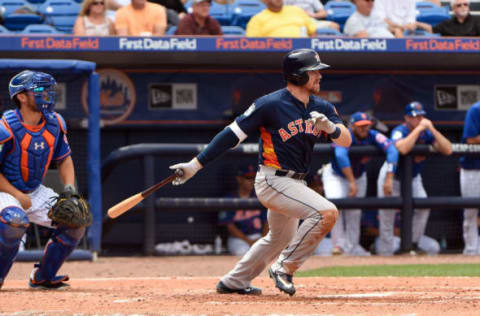
By: Reed Graff
Next
Derek Fisher was a supplemental pick of the Houston Astros in the 2014 Major League Draft, in which the Astros made him the 37th overall pick. He could be the player that saves the disastrous draft class that was 2014 in which the Astros failed to sign the #1 overall pick Brady Aiken.
In his time in the system, Derek Fisher has shown the offensive ability that had him widely considered the top college bat in the 2014 draft. Through 351 career minor league games, Fisher has a .283 average with 61 home runs and 88 stolen bases. He has lit up Triple-A pitching this season, to the tune of a .338 batting average, 16 home runs, 43 Rbi’s, and 12 stolen bases.
The numbers speak for themselves. Fisher is major league ready. The main knock on Fisher, however, is that he has a high strikeout rate, striking out 373 times in 1359 minor league at-bats. While strikeouts may always be a part of his game, Fisher has above average speed, the power to hit 20+ home runs regularly, and the defensive skills to lock down a corner outfield spot.
The 23-year-old could start for Houston right now, and he will likely finish this season either playing for another team due to trade or locking down left field in Houston.
Future
The future of the outfield and possibly the best prospect in the Astros system is 20-year-old Kyle Tucker. A member of the 2015 draft class that included Alex Bregman and Daz Cameron, Tucker has shot up the minor league system and shows an advanced ability to hit.
The younger brother of fellow Astros outfield prospect Preston Tucker, Kyle is a more athletic and better-built player. He can be a very good corner outfielder. He is still growing into his body, and he already possesses solid power, speed, and defensive skills. So far in his minor league career, he has hit 22 home runs, which isn’t a huge number, but he is still growing into his 6’4 frame, and as he does so, the power should develop.
He has a career average of .275 and his 64 stolen bases speak volumes to the versatility he has. While he profiles best as a corner outfielder, he could play some center. My favorite stat with Tucker is the career on-base percentage of .345.
If he can continue to improve his approach at the plate and develop into a solid power hitter, the Astros could have a .275 hitter that can eclipse 30+ home runs and 20 stolen bases. Tucker could potentially make the team late next season if he continues his development. However, the following season is more realistic.
Backup

There are several names I could list here. Teoscar Hernandez and Tony Kemp both have major league experience in which they played well, but I am going to stick with the Tucker family on this one. Preston Tucker has some major league experience as well, as he hit .243 with 13 home runs his rookie season in 2015 before an injury-riddled 2016 ruined his stock as a prospect.
Tucker is a solid left-handed bat with above average power, and the ability to drive the ball to all corners of the park. He doesn’t strike out a ton, striking out only 68 times in 300 at bats in 2015, and at the age of 26, he has a lot of good baseball ahead of him. For the Fresno Grizzlies this season, Tucker is hitting .253 with 11 home runs, and an on-base percentage at .292. Where Tucker falls short, however, is his athleticism and versatility.
Preston is limited to left field and first base. His best spot is probably as a Designated hitter. He does not have a great arm, and he is not particularly fast on his feet. In his extended time in Houston in 2015, his defense was lackluster. This limits him to DH duty or even pinch hitting. He has value as a left-handed power bat, but he does not project well as an everyday starter.
Still, Preston Tucker could see time in Houston if something were to happen and left-handed hitting was a need. He is more proven than fellow lefty slugger AJ Reed, and he would be productive in Houston if need be.
Depth
My pick for a depth guy in the system isn’t the name you are going to be expecting. While Ramon Laureano and Daz Cameron both show some solid potential, Jason Martin is an athletic, productive outfielder at Double-A Corpus who I have been following for the past few seasons. Martin was drafted out of high school in the eighth round of the 2013 MLB draft, and his development has been a fun one to watch.
Only 17 at the time he was drafted, Martin has developed into a solid outfield prospect. A Career .267 minor league average doesn’t sound great, but if you look into his numbers, you can see his progression. At 18, he hit .251 in the rookie league, before struggling at Tri-City in 2014, hitting only .221. Since then, he has yet to finish a season under .270, and last season, Martin broke out.
He slugged 23 home runs for Lancaster, and followed that up by tearing apart A ball this season with Buies Creek, hitting .287 with seven home runs and nine stolen bases in 46 games. He was recently called up to Corpus with fellow prospect Kyle Tucker, and through 6 games, is hitting .217 with two home runs.
Martin may need a season or two in AA ball, but his development has been a fun one to track, and he could be the next under the radar prospect of Jeff Luhnow’s drafts to break out as a legitimate prospect.
Need: Moderate, Level 3.
Starting Pitchers
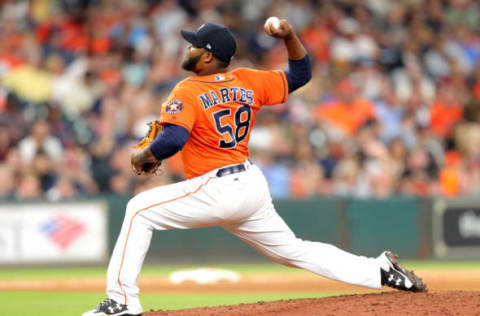
By: Eric Huysman
Next: Francis Martes (#1, MLB Pipeline)
Next: David Paulino (#3, MLB Pipeline)
Back of the rotation: Cionel Perez (#16, MLB Pipeline)
Back of the rotation: Dean Deetz (#30, MLB Pipeline)
MiLB Depth: Brady Rodgers (#24, MLB Pipeline)
Future: Forrest Whitley (#5, MLB Pipeline)
Future: Franklin Perez
Deep Future: Framber Valdez
While the names on this list could be top pitchers someday, the pitching at Triple-A has been suspect this year. Top prospect Martes was called up to the big leagues, but he has 28 walks in 32 1/3 innings pitched this year. With Dallas Keuchel hitting the DL and the impending return of Joe Musgrove, it is not clear what Martes role will be.
Paulino’s role has increased this year with the injuries as well. These are the obvious two pitchers to help the Astros in the future, but who else?
The others.
Rodgers struggled last year in his first season with the Astros but showed promise. Unfortunately, he had Tommy John surgery earlier this year. This is the first time that Deetz has appeared on this list, but it’s long overdue. Deetz went 4-2 with a 1.82 ERA with 42 strikeouts in 39 2/3 innings. He struggled in his first start in Triple-A, but he’s a rising star.
Whitley was drafted in the first round last year and is performing well at the lower levels. However, he is still young, straight out of high school. Don’t look for him to be ready until 2019-20. They will groom him to be a top of the rotation caliber starter.
Cionel Perez and Valdez are both left-handed pitchers who are still young. Cionel is the pitcher the Astros signed twice from Cuba. He has gotten off to a tough start, but Valdez is performing like a future starter.
Franklin Perez is an emerging star, this year he is 2-0 with a 3.00 ERA with 23 strikeouts in 24 innings. He is currently at High-A Buies Creek but could be on the rise with promotions and trades in the system. Perez could be on the move in a trade as one of the top Astros pitching prospects.
You can never have enough starting pitching talent in the system. The Astros pitching depth has been challenged this year, so I could see the Astros going after a college level pitcher.
Need: High, level 2.
Relief Pitchers
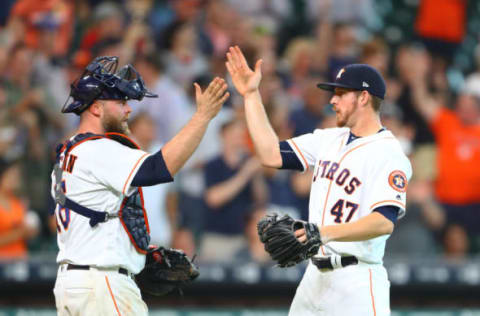
By: Clint Irle
Francis Martes – RHP
David Paulino – RHP
Franklin Perez – RHP
Cionel Perez – LHP
Jandel Gustave – RHP
Brady Rodgers – RHP
Brendan McCurry – RHP
Jorge Alcala – RHP
Framber Valdez – LHP
Dean Deetz – RHP
One of the unique aspects of being a relief pitcher is the resolve one should have to take on any situation. Relief pitchers are not always given the best circumstances but are called upon to get the outs and end the inning.
The Astros currently house numerous pitching prospects that offer great optimism for the organization’s future. Some of these are repeats from the starting pitcher section.
What we have.
We can’t forget the current relievers at the major league level; Michael Feliz, Brad Peacock (floater), Dayan Diaz and Chris Devenski.
While our talent pool is deep, there is a lack of left-handed pitchers. Of these notable names, only two of them are left handed. We all know how difficult match-ups can be without a left-handed reliever in the bullpen.
As the season plays out, some guys will transition to a starting role. Others will be bullpen assets. The most important thing is to find who fits each role mentally. These young arms will need time for development, which will provide the Astros with everything they need to put together a solid pitching staff.
Next: Top five risky trade ideas.
Need: Roles aren’t determined when drafted, but get pitchers who fit the Astros mold. Moderate, level 2. The Astros will draft best available, but we have an idea of what they will target. We will cover the draft for the next several days.
***Stats from Baseball-Reference, MLB.com, and Fangraphs**